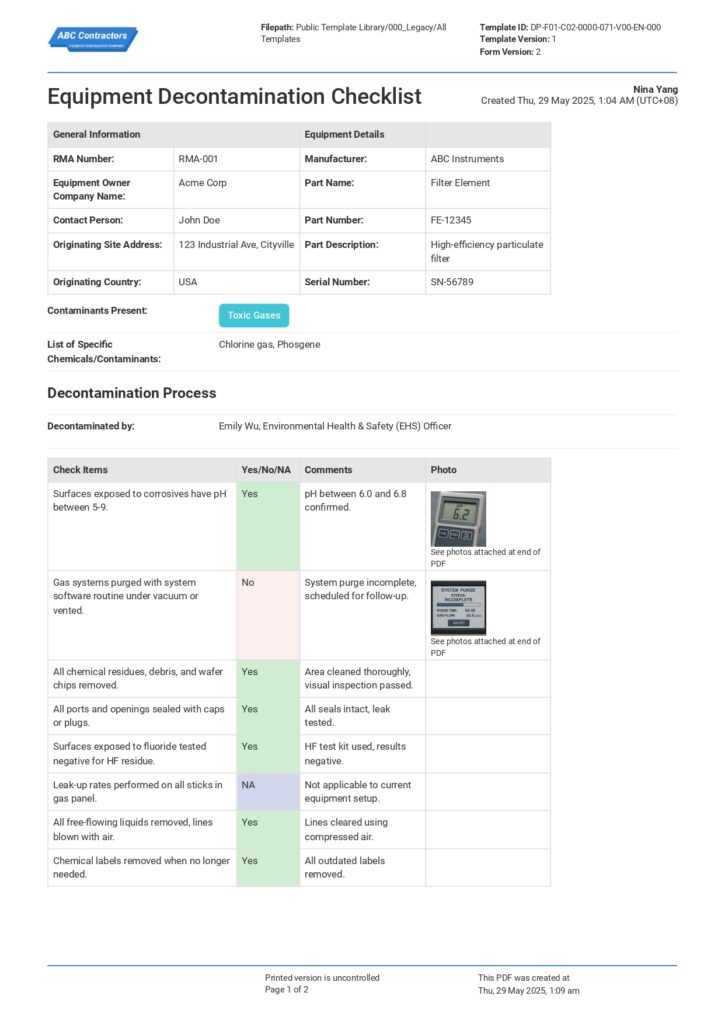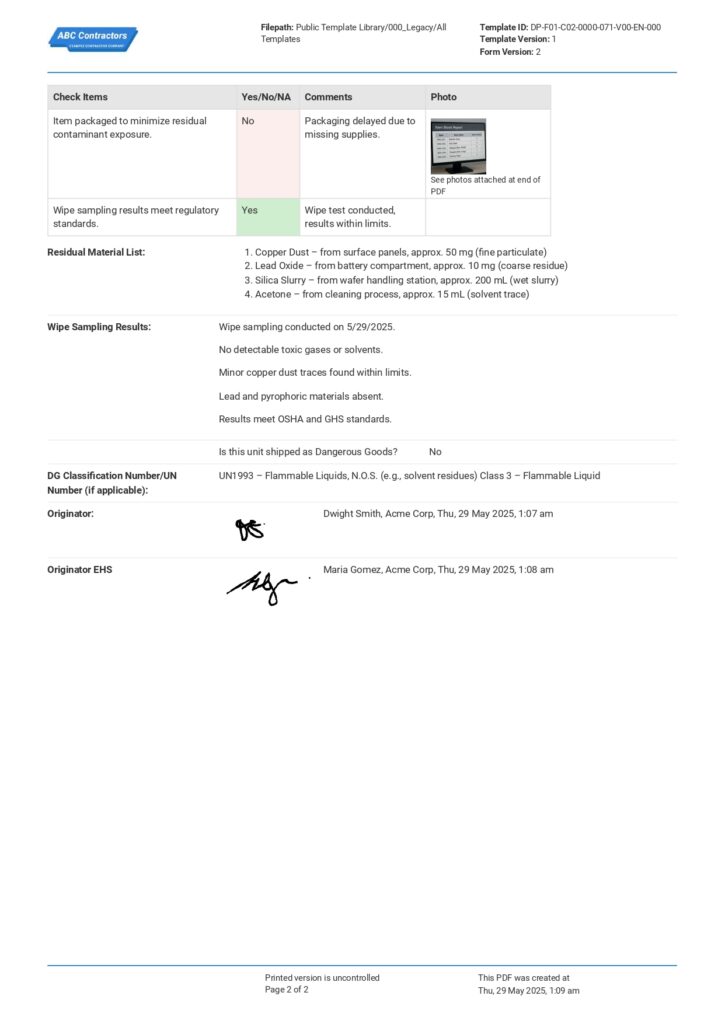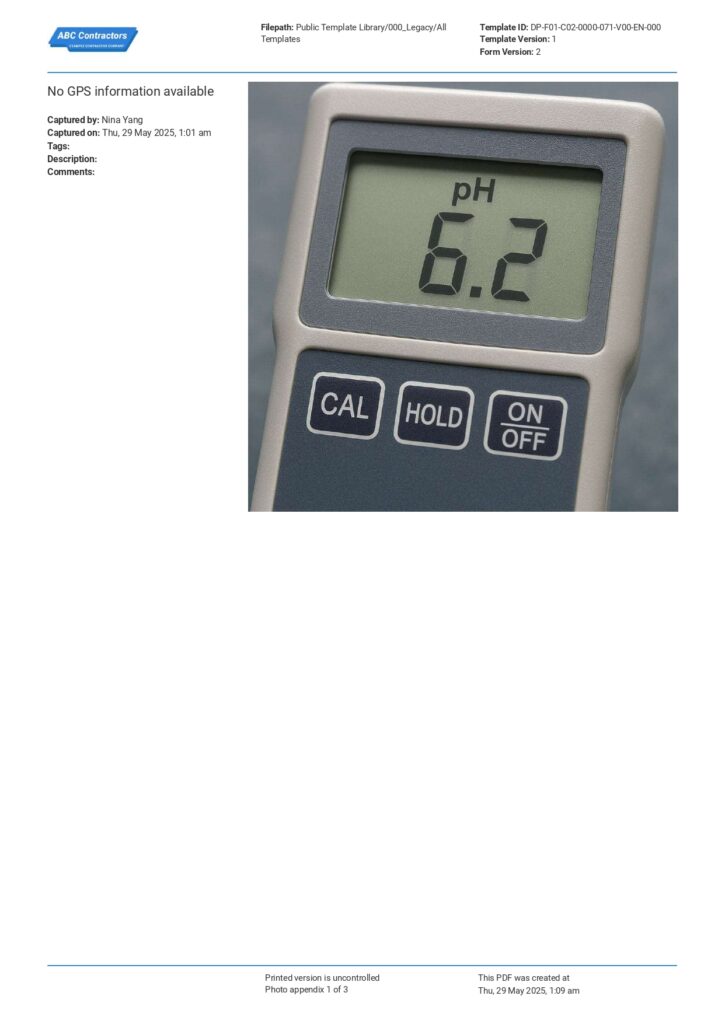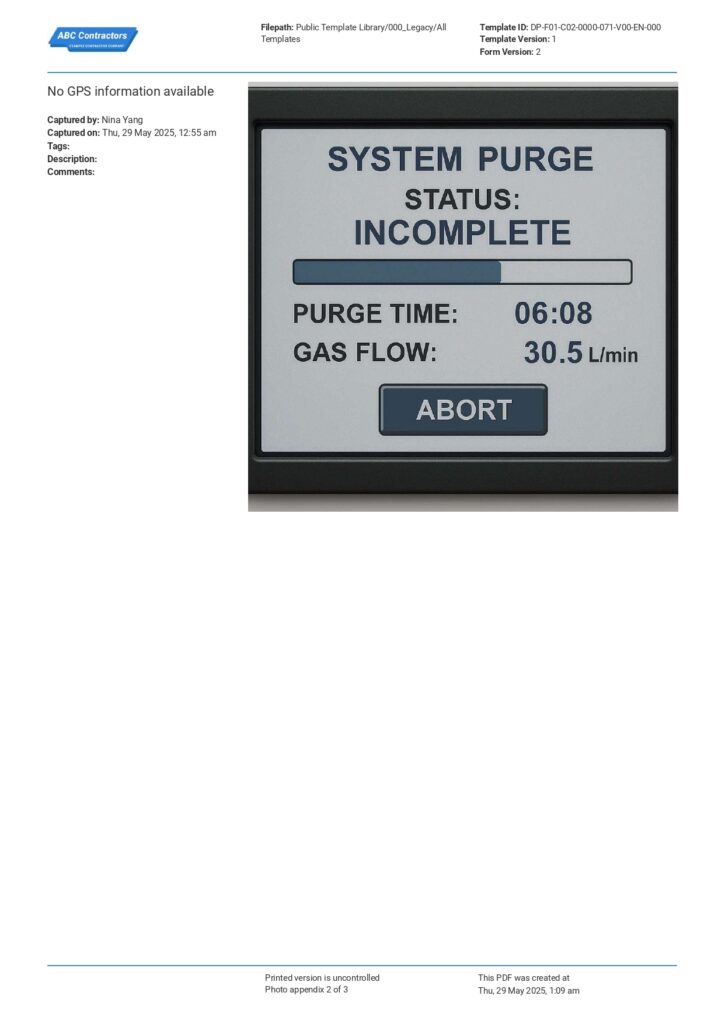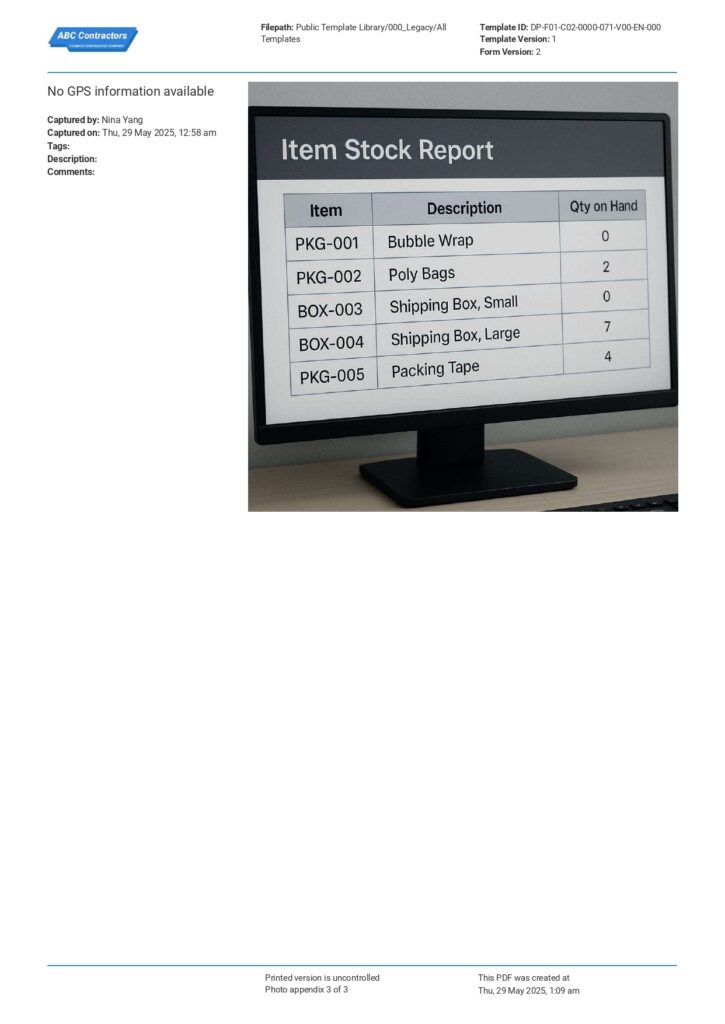Equipment Decontamination Checklist Template
Start with a free 30-day trial. No credit card required.
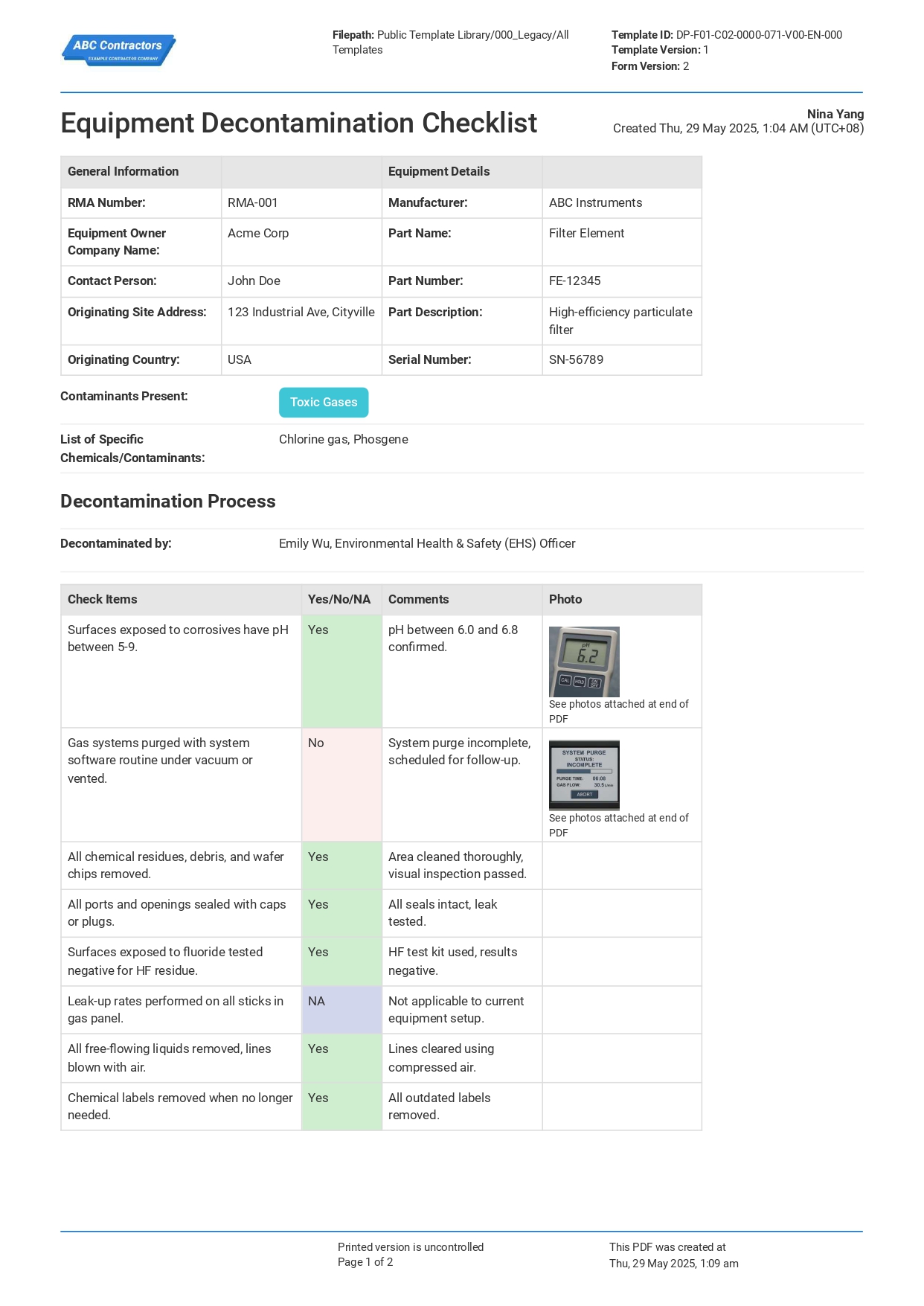
~10,000 employees
~500 employees
~25,000 employees
~20 employees
~50 employees
~1,500 employees
~20 employees
What is an Equipment Decontamination Checklist?
An Equipment Decontamination Checklist is a documented list of quality inspection items to cross off after decontaminating an equipment. Equipment decontamination is an essential procedure for removing hazardous materials or contaminants from the surfaces of exposed equipment, which is highly relevant in the electronics manufacturing, healthcare and energy industries. It involves critical decontamination methods such as chemical cleaning, sterilization, gas purging, or high-pressure rinsing, and post-care including proper packaging and marking.
This is why it’s necessary to have a high-quality equipment decontamination checklist that would clearly document non-compliances and detailed equipment decontamination to address them right away before the next exposure, to avoid health and safety risks such as toxic exposure, equipment damage, and operational failures.
Compare this detailed decontamination equipment form from other paper-based checklists made using Word, Doc or Excel
Use this Equipment Decontamination Checklist template for free.
What is included in an Equipment Decontamination Checklist?
The key components included in equipment decontamination checklists are equipment identification details, types of contaminants present, and the list of decontamination process check items an inspector must go through to verify the inspection.
Regardless of the industry, the checklist is an essential tool in verifying that the equipment is decontaminated correctly and in accordance with regulatory compliance, while also assuring safety. Each component ensures that the process is consistent and compliant. For instance, the equipment identification not only identifies the equipment, which is essential for traceability, but can also include manufacturing information to give further insight to the company if there are tendencies of failure to decontaminate due to the quality of the equipment.
There is no standard format for how this checklist should be formatted; however, it would be beneficial for the document to be well-structured and easy to navigate in order to go through each key component carefully and ensure conformity in each process.
Steps in resolving equipment decontamination non-compliances
There are key steps in resolving non-compliances identified in equipment decontamination checklists, and the primary goal is to have an immediate resolution. Equipment sanitation is important in any industry, as it helps prevent contamination, which would negatively impact both the equipment and the products or materials used by the equipment. In some cases, especially when equipment has reached the end of its lifespan, it may require equipment decommissioning or the removal of the equipment to prevent further safety risks because you cannot decontaminate it anymore. In this scenario, it is important to transition to an equipment decommissioning checklist for the guidelines and the set of check items to follow to safely and legally remove equipment from operation, as it involves critical considerations such as disposal of the equipment, hazardous materials, and essential documentation of the removal process.
The following are the key steps to resolve non-compliances identified from the checklist:
- Isolation of the non-compliant equipment - This is done by removing the equipment from regular operations, it should be marked non-compliant to be easily identifiable and to prevent cross-contamination
- Document the non-compliance issue and record – Documenting the non-compliance would be alongside the visual inspection and to confirm if further decontamination and resolution is still possible.
- Conduct root-cause analysis – Perform root-cause analysis upon identifying the problem. This involves evaluating why the non-compliance has occurred. Common causes of failed decontamination include chemical contamination, incomplete purging (e.g., if the decontamination process was not followed), end of the equipment’s usefulness, or ineffective materials used for decontamination.
- Make corrective and preventive actions – The corrective and preventive actions would depend on the non-compliance detected. In most cases, corrective actions involve re-cleaning the equipment. In manufacturing industries, where incomplete purging is common, you need to re-run the purging. Preventive actions can include upgrading the decontamination equipment.
These four steps are necessary in resolving non-compliances identified in equipment decontamination checklists. It would be beneficial that a checklist is integrated in a software that can manage a full approach in non-compliance resolutions because in enables proper documentation, regulatory compliance and fast-tracked closure of results.
How does an equipment decontamination procedure ensure regulatory compliance?
Performing an equipment decontamination procedure using an Equipment Decontamination Checklist ensures regulatory compliance in two ways: first, by guiding responsible inspectors through each check item in the decontamination process, ensuring a uniform procedure; and second, by making sure appropriate documentation aligns with regulatory bodies such as the Occupational Safety and Health Administration (OSHA) and the Environmental Protection Agency (EPA).
Ensures Uniform Procedures
Using a checklist that is aligned with regulations set by regulatory bodies like OSHA and EPA strengthens the company’s goal of regulatory compliance. An Equipment Decontamination Checklist guides the originator or responsible person to check off each standard and ensures all standard procedures are followed, that the equipment is free from contamination, reduce chemical exposure risk for the equipment user, and prevents corrosion-related hazards, among many other protections.
Provides Audit-Ready Formats
Proper documentation is necessary to achieve a detailed inspection and audit-ready format. A well-structured checklist helps establish clear traceability and record keeping. For example, when a checklist can be reviewed in real time, it helps the team easily identify the next steps and verify task completion, which is also highly essential during audits to confirm adherence to documentation standards.
As a reviewer, if there are actionable items identified, you can also conveniently set up workflow notifications to alert an inspector of this task or send this checklist to a colleague. This automated system already sets you up for an audit-ready process flow that ensures compliance.
Frequently Asked Questions
Why is this the best Equipment Decontamination Checklist template?
Sitemate's Equipment Decontamination Checklist Template is the best inspection checklist template because it is already proven by thousands of equipment maintenance companies. It comes pre-built to align with maintenance best practice, and is quick and easy to use for any type of worker.
Is this template compliant with OSHA and EPA standards?
Yes - this template is configured to align with both OSHA and EPA standards as the checklist includes critical items such as having the specific contaminants detailed, verifies if chemical labels are removed and photo documentation is included. These can be further configured to align with specific standards.
Can I edit this checklist for different types of equipment?
Yes - the template is completely editable with easy drag-and-drop functionality. You can create thousands of potential document setups using different field types including tables, formulas, sketches, photos and more, to cater to any type of data capture, as well as add your company logo, custom headers and other important structure. All of this configuration is powered by Dashpivot's template builder.
What formats is this Equipment Decontamination Checklist available in?
This template can be used across all devices. This means you can edit and fill out forms on your computer, or access and complete equipment inspections directly from the field. Once filled out, any record in the system can be exported as PDF or CSV, meaning you get the best of Word Doc, PDF and Excel, with the power of modern software.
Other popular templates you can use and edit for free

Equipment Maintenance Log
Perfect for supervisors who are looking to upgrade their traditional maintenance logs.

Preventive Maintenance Checklist
After you go through this smart checklist, it syncs and saves instantly-no more paperwork.

Commercial Cleaning Checklist
Allows cleaners to easily check off items as they work, and supervisors can review instantly from the office.
This smart checklist was generated with Dashpivot software
Instantly improve your equipment decontamination workflow by going digital in both process and documentation.
- Access and fill out your decontamination checklists and forms from any device - mobile, tablet or computer.
- Print or share your equipment/hazmat/ppe decontamination checklists as perfectly formatted PDF documents with your company logo.
- Store your checklists securely online, where they can be searched and found in seconds
- Invite your team or clients, edit and sign off on checklists online.
Sitemate builds best-in-class software tools for built world companies.
